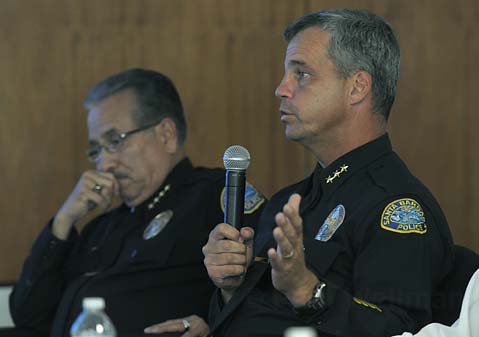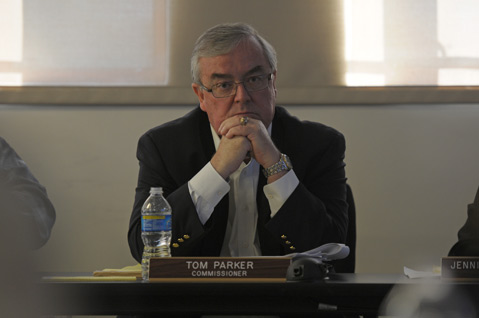Cherry Picking Crime Stats
Assistant Chief Takes Police Union to Woodshed

Assistant Santa Barbara Police Chief Frank Mannix publicly teed off on Detective Jaycee Hunter last Thursday, accusing Hunter — a spokesperson for the Police Officers Association— of “overstating the facts, understating the facts, and plain-old fashioned misstating the facts.” Mannix’s remarks came during a five-hour meeting of the Fire and Police Commission, where he sought to rebut Hunter’s contention — delivered in city council chambers a month ago — that crime rates were going up, arrests rates were going down, and officer response times were slowing down. At that time, Hunter unveiled reams of statistics he claimed showed the extent to which public safety has been compromised as the number of authorized sworn officers has shrunk from 152 to 137 over the past 10 years in the face of chronic budget woes. “Jaycee Hunter is a very good detective,” Mannix said, “but he’s no crime analyst.”
Before becoming an administrator, Mannix spent 10 years as an active member of the Police Officers Association (POA), negotiating five contracts for the union and heading the union’s influential political action committee. “I can’t support cherry-picking data to provide impressions of crime trends that do not exist,” he said after last week’s meeting. “I never did that when I was with the POA, and I don’t know what’s happened with the POA for that to happen now.” Mannix bombarded the Fire and Police commissioners with a blizzard of facts and figures of his own, all indicating that crime rates — in general — have gone down or held steady during the past 10 years, while arrests have gone up and response times have met or exceeded department goals. Furthermore, Mannix contended that it’s simply not possible to establish any link between crime rates and the number of police officers. “Major reductions in crime occurred in periods when we were losing significant staff,” he said.

As a rule, cops are loathe to air their differences in public. But the POA’s contract has just expired and City Administrator Jim Armstrong — in response to a $9-million budget shortfall — has been pressuring all public employee unions to accept significant wage and benefit cuts. The budget approved by the city council three weeks ago is predicated upon the assumption that the unions representing police officers and firefighters agree to cuts worth $2 million. Without such concessions, Armstrong has said he’ll have to impose even deeper cuts on other city programs. The POA’s real beef is with Armstrong — who they contend is hiding millions of dollars in reserves that would obviate the need for any concessions — and not with Chief Cam Sanchez or Mannix. But with his presentation last month, Detective Hunter infuriated Sanchez by charging the police department itself was massaging its response-time numbers for serious crimes — arbitrarily excluding all response time over 30 minutes — to keep their averages artificially low. At the time, Sanchez fumed Hunter never aired his concerns within the department. Last week, Mannix lowered the boom.
According to Hunter, residential burglaries rose 133 percent between 2001 and 2009; DUI collisions, 200 percent; sexual assaults, 65 percent; and kidnapping, 300 percent. But according to Mannix, violent crime dropped to a 10-year low in 2009, down to 399 reported incidents. That compares to 470 in 2000 and a high of 641 in 2004. If currents trends continue, Mannix said, there will be 348 violent crimes reported in 2010. Mannix did concede there was “a bloom” in residential burglaries last year, but said the department has focused on that issue and appears to have made progress. (The spike in burglaries may be related to the massive anti-gang sweep known as Operation Gator Roll. In that, detectives working narcotics were re-assigned to the gang detail. While gang activity went down, the illegal drug trade went up, and residential burglaries increased with the ensuing addiction problems.)
In some instances, Mannix said Hunter’s numbers were just wrong — as in DUI collisions — but in others, they failed to account for changes in how the department tabulates crime. Since 2001, the police department has used three different computer programs keeping crime statistics. In that same time, the department’s policies for logging reported crimes has changed, as well. In 2008, for example, the department started counting as “sexual assaults” reports that previously had been filed in a separate category as “suspicious circumstance sexual assault.” These cases involve victims who may have been assaulted but, for a host of reasons, aren’t sure what happened or whom it happened with. Likewise, any time victims claim to have been held against their will, the department now logs that as a kidnapping. However these cases are categorized and labeled, Mannix said, the number of arrests is increasing. Last year, for example, the department reported 20,488 arrests compared to 18,548 in 2005 and 14,315 in 2001.
As for Hunter’s charge that the department massaged response-time numbers, Mannix said only one serious call was filtered out in the past six months, and that involved an injured bicyclist who lost control while driving over a speed bump. Police did not respond because the cyclist had been taken by ambulance to the hospital. Had that call not been filtered out, Mannix said, the department’s monthly response times would have been slower by a minute. In the previous year, 11 priority calls were similarly filtered.
Like beauty and pornography, the meaning of statistics lies in the eye of the beholder. Mayor Helene Schneider and Councilmember Harwood “Bendy” White were on hand for Mannix’s rebuttal, and both said they were impressed by the thoroughness and clarity of his work. Schneider and White will have a major say in what concessions, if any, city hall will insist on from the POA. More critically, they — as well as the entire council — will be on the hot seat if and when the council declares an impasse in negotiations. Should that occur, the council is empowered to impose a contract on the police union. The union, not legally allowed to strike, could respond by providing the bare minimum of legally required service and no more.
Former POA president Charles McChesney attended the meeting, as well, and said Mannix was unduly personal in his remarks and that Hunter’s concerns — however inflammatory he may have been in expressing them — remained valid. POA President Mike McGrew, who did not attend the meeting, conceded that violent crime is down from 20 years ago, but that the experience of officers in the street is getting decidedly nastier. “You can’t tell me that we are providing the same level of service to the people in this town with 137 cops as we did with 152,” he said. “That’s just not real.” Mannix said that through it all, the department has managed to maintain a consistent level of field strength. This, coupled with newfound operational efficiencies and stricter sentencing guidelines for violent criminals, has helped keep a lid on crime. “From the trends over the past 13 years, we are not experiencing a crime wave,” Mannix said. But he also conceded that some departmental programs — like the popular beat coordinator — have suffered as police administrators redeployed and reassigned officers to deal with the diminished numbers.

Fire and Police Commissioner Tom Parker — a former FBI agent and white collar crime security consultant — insisted that even Mannix’s own statistics indicated that crime was generally on the rise, though with peaks and valleys. When Parker told him this, Mannix replied, “Except our crime rates are going down, not up.” Parker also asked about anecdotal accounts how officers, on occasion, simply never show up to calls for service. Chief Sanchez replied that such officers are simply fired. Last year, he said one officer lost his job for just that.
Parker said he’s heard detectives express frustration about being reassigned off their caseload to uniform patrol because of staffing issues. When he brought this up during a monthly meeting to analyze recent crime trends, he said Sanchez got upset. Parker noted that shortly after the Fire and Police Commission meeting a month ago — at which Hunter delivered his critique — Sanchez notified him via email that no one outside the department would be allowed to attend the monthly crime trend briefing. Parker — who has locked horns with Sanchez in the past — suspected the decision was retaliatory in nature. He broached the subject last Thursday, starting off, “I’m sorry to ask this question.” Sanchez quickly jumped in, stating, “I’m sorry you asked that question because I asked you not to,” prompting Parker to reply, “And that’s exactly why I’m asking it.” Sanchez said some in the department expressed discomfort at having individuals outside the department — city administrators, councilmembers, and commission members — involved. “It’s not personal,” Sanchez said. “I asked you not to take it personally.” Parker replied, “I do have to say the timing seemed quite strange.”


